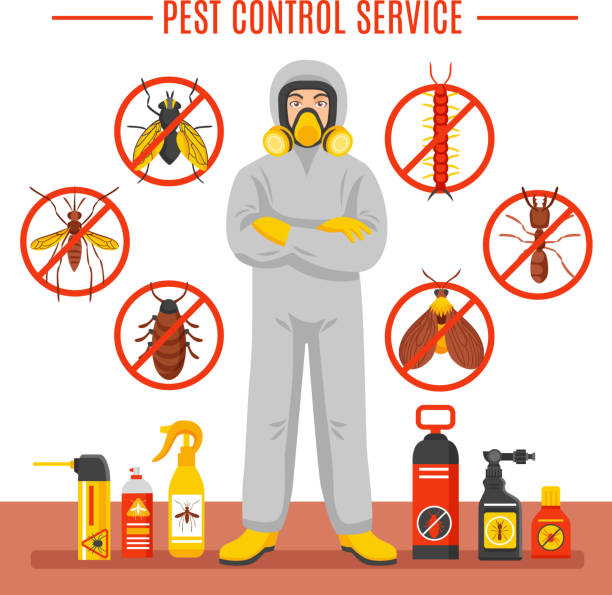Exploring Infestation and Therapy Techniques on the planet of Pest Control
The landscape of bug control encompasses a myriad of difficulties, especially as problems of typical house pests continue to evolve. By integrating precautionary procedures with innovative management strategies, such as Integrated Insect Management (IPM), property owners can better safeguard their settings.

Typical Household Vermin
When it involves handling our space, understanding typical house parasites is important. These parasites not only disrupt our comfort however can additionally pose wellness risks and damage home. One of the most prevalent family pests consist of ants, roaches, rodents, termites, and bed insects.
Ants, often seen foraging in kitchen areas, can pollute food and develop large colonies. Roaches, recognized for their strength, can set off allergies and spread pathogens. Rodents, consisting of mice and rats, can trigger structural damages and bring diseases like hantavirus and salmonella. Termites, often described as "quiet destroyers," can compromise the honesty of wooden structures, bring about costly repair work. Bed insects, although not condition carriers, can trigger substantial discomfort through their bites and lead to emotional distress.
Identifying the signs of these parasites, such as droppings, nests, or attack marks, is essential for very early treatment (Pest Control Lockhart). Proper cleanliness methods, securing access factors, and preserving a clutter-free atmosphere are effective preventative procedures. By recognizing these usual household pests and recognizing their behaviors, property owners can take aggressive actions to alleviate invasions, ensuring a healthier living setting
Comprehending Parasite Infestations
Parasite problems can rise swiftly, transforming a minor aggravation right into a substantial trouble if not dealt with without delay. Usual factors adding to infestations include poor sanitation, structural susceptabilities, and seasonal changes that drive parasites inside your home.
Identifying the sort of parasite is essential, as different varieties exhibit varied actions and reproductive prices. Rats might develop nests in hidden areas while pests like roaches prosper in moist environments. Early detection usually rests on acknowledging indications such as droppings, chomp marks, or unusual noises, which can show an issue prior to it comes to be severe.
Cozy, moist environments can promote the fast growth of pest populations, while adjustments in landscape design or building can inadvertently produce favorable atmospheres. An informed method to recognizing these dynamics lays the groundwork for effective insect administration approaches in the future.
Treatment Methods and Strategies
Effective therapy techniques and techniques are vital for mitigating parasite invasions and restoring a safe environment. A diverse strategy is frequently best, integrating chemical, biological, and mechanical strategies customized to the certain parasite and the severity of the problem.
Chemical therapies consist of using insecticides and herbicides, which can properly remove insects. Nonetheless, proper application and adherence to security standards are critical to decrease risks to human beings and non-target organisms. Integrated Insect Management (IPM) motivates the cautious use of chemicals as a last hope, relying instead on tracking and limit levels to determine treatment needs.
Biological control techniques involve introducing natural killers or bloodsuckers to decrease parasite populaces. This approach is progressively popular, particularly in farming setups, as it promotes ecological sustainability.
Mechanical techniques, such as traps and barriers, give instant relief from bugs without introducing chemicals. Choices consist of sticky catches for pests or physical obstacles for rodents.
Ultimately, the selection of treatment method must consider the details bug, the setting, and prospective impacts on human wellness and environments. A well balanced mix of these approaches can successfully take care of infestations while advertising lasting bug control services.
Safety Nets for House
Proactively attending to parasite issues before they escalate is crucial for keeping a healthy and balanced home setting (Pest Control Lockhart). Carrying out efficient preventive measures can dramatically lower the chance of infestations, inevitably protecting both your building and well-being

Appropriate landscape design additionally plays a critical duty in prevention. Keeping shrubs and trees trimmed away from the More Help home lowers the chances of bugs discovering their means inside. In addition, ensure that drainage systems are working efficiently to stop standing water, which can attract in insects and other insects.
Finally, regular evaluations sites are a good idea. Consistently checking for indicators of parasite activity permits very early intervention. By adopting these preventive measures, homeowners can produce an atmosphere that is less friendly to parasites, therefore boosting their total quality of life and reducing the need for substantial bug control treatments.
Industrial Pest Control Techniques
A thorough approach to industrial bug control is vital for businesses intending to preserve a safe and hygienic environment. Reliable techniques include a combination of routine inspections, worker training, and the execution of Integrated Pest Administration (IPM) methods.
Routine assessments enable very early detection of parasite task, enabling for prompt intervention. Organizations need to establish a regular timetable for these assessments, concentrating on high-risk locations such as kitchens, storeroom, and garbage disposal websites. Staff member training is just as vital; team must be informed on the indicators of pest problems and the importance of reporting them promptly.
Implementing IPM methods assists reduce parasite concerns sustainably. This includes environment my review here alteration, such as securing entry factors and lowering clutter, as well as using all-natural deterrents prior to turning to chemical therapies.

Furthermore, working together with a certified parasite control copyright makes sure access to professional understanding and innovative therapy choices. This partnership can result in tailored insect control prepares tailored to the certain demands of business, minimizing dangers and boosting overall effectiveness. Ultimately, a proactive and enlightened strategy promotes a pest-free setting, securing both public health and business track record.
Conclusion
In verdict, efficient parasite control requires a detailed understanding of common household parasites and their habits, combined with targeted treatment methods. Applying safety nets along with treatment strategies such as Integrated Insect Monitoring and organic control boosts the capacity to minimize invasions. Routine assessments and a mix of chemical and mechanical services better add to preserving pest-free atmospheres. Ultimately, a well-rounded technique to pest monitoring is crucial for securing living areas from undesirable intruders.